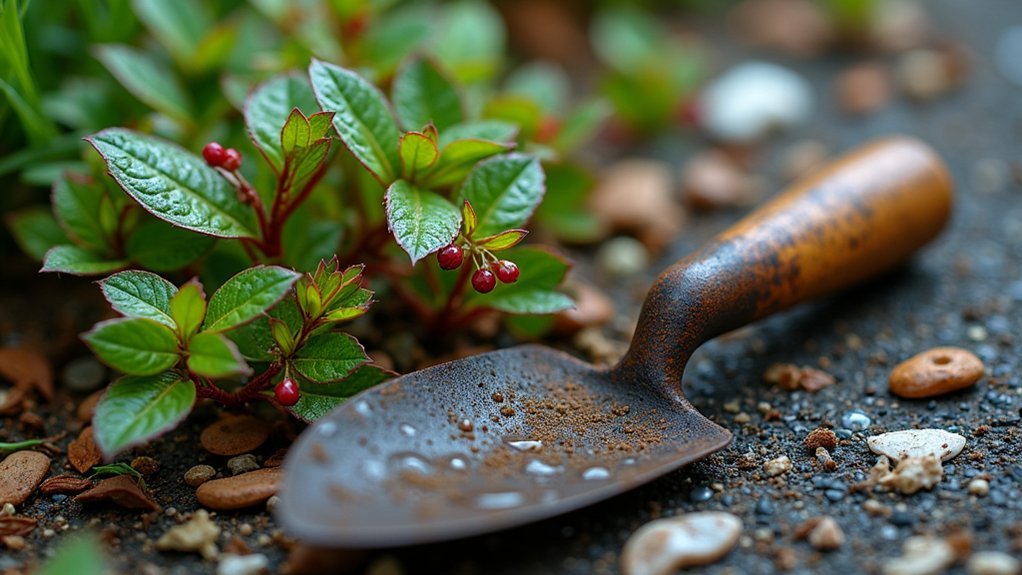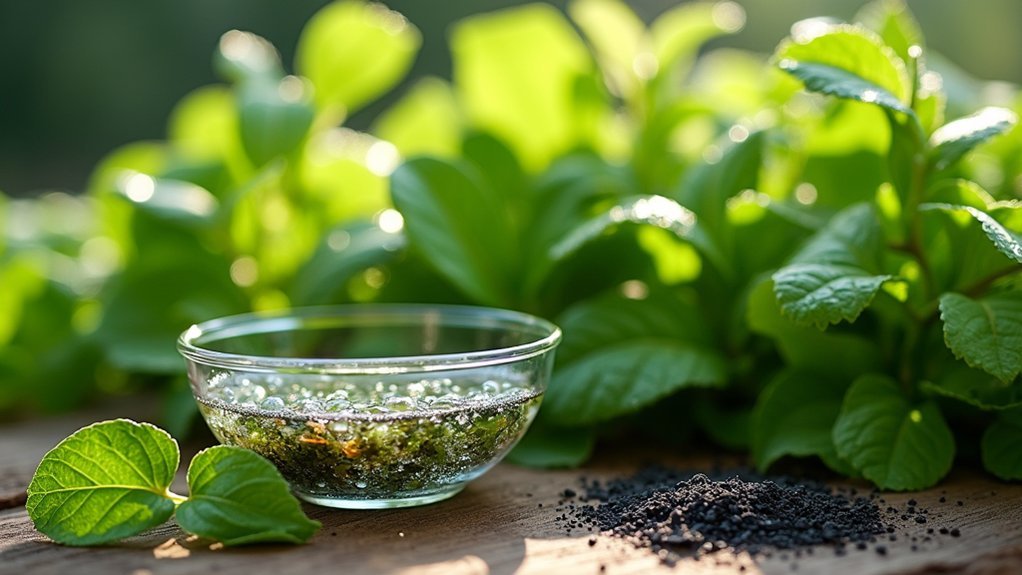To remove pollution from foraged plants, you'll need three effective techniques. First, rinse thoroughly under cool running water to remove surface contaminants. Second, soak in a vinegar solution (1 part white vinegar to 2 parts water) for 15-20 minutes to eliminate bacteria and residues. Third, scrub tougher specimens gently with a soft brush while avoiding damage to delicate parts. These cleaning methods will transform your urban harvests into safe, nutritious additions to your meals.
Washing Techniques For Wild Urban Plants

When foraging plants from urban environments, you'll need to thoroughly clean them to remove potential pollutants.
Always thoroughly rinse your foraged plants under cool running water to remove dirt and surface contaminants. This simple technique is your first defense against urban pollution.
For extra protection, soak your edible plants in a vinegar solution (1 part white vinegar to 2 parts distilled water) for 15-20 minutes, gently agitating them. This helps eliminate bacteria that might compromise their health benefits.
After soaking, strain and rinse again under cool water to remove any vinegar residue.
Handle delicate finds like mushrooms differently – avoid soaking them completely, as they'll absorb too much water. Instead, clean them with a gentle rinse.
Finally, use a salad spinner to remove excess water before preparation.
Soaking Solutions To Extract Environmental Contaminants
Beyond basic rinsing, specialized soaking solutions offer a more thorough approach to removing harmful contaminants from your foraged plants. A mixture of 1 part white vinegar to 2 parts distilled water provides an effective 15-20 minute soak that helps remove surface contaminants and bacteria, increasing food safety.
For insect removal, try a 10-minute saltwater bath, which efficiently dislodges bugs and loosens dirt from your harvest.
Begin your cleaning process by rinsing plants under cool running water to remove larger debris before applying these soaking solutions. Delicate greens benefit from cold water rinses that preserve texture while cleaning.
Always thoroughly inspect plants after soaking, as some environmental contaminants may persist despite your efforts.
For ideal health benefits, prioritize foraging in organic areas away from pollution sources and use clean water for all soaking procedures.
Physical Removal Methods For Urban Plant Debris

Three essential physical techniques can effectively clean urban-foraged plants before consumption. When harvesting from potentially contaminated soil, responsible foraging demands thorough cleaning to minimize potential health risks from Heavy metals and pollutants.
Urban foraging requires diligent cleaning practices to protect against environmental contaminants hidden in city-grown plants.
- Rinse thoroughly – Place plants under cool running water to dislodge surface dust and loose debris that may harbor toxins.
- Soak methodically – Use a colander in a clean water bath, allowing plants to float while contaminants sink to the bottom.
- Scrub gently – For tougher specimens, employ a soft brush to remove stubborn particles without damaging delicate parts.
- Chemical assistance – Soak in a vinegar solution (1:2 ratio with distilled water) for 15-20 minutes to help eliminate bacteria and residues.
After cleaning, air dry your plants completely to prevent spoilage before cooking or storing.
Frequently Asked Questions
How to Properly Clean Foraged Herbs?
To properly clean foraged herbs, rinse them under cool water, soak in a vinegar-water solution for 15-20 minutes, spin dry in a salad spinner, air dry on a towel, and inspect carefully before use.
How to Clean Edible Plants?
Rinse your edible plants under cool water, then soak them in vinegar solution for 15-20 minutes. Use a salad spinner to dry them thoroughly. Inspect carefully to guarantee all dirt and insects are removed before eating.
How to Wash Wild Greens?
To wash wild greens, rinse them under cool running water, then soak in a vinegar-water solution for 15-20 minutes. Agitate gently, rinse again, and spin dry. Don't forget to inspect for remaining debris.
Is It Safe to Eat Roadside Plants?
No, it's not safe to eat roadside plants. You shouldn't consume them as they absorb pollutants like heavy metals and chemicals from vehicle emissions. These contaminants can extend up to 100 feet from roads.
In Summary
You're now equipped to safely enjoy urban foraging despite pollution concerns. Remember to wash thoroughly, soak in acidic solutions, and carefully trim away contaminated parts. With these three methods, you're taking important steps to minimize your exposure to environmental toxins. As you continue exploring wild urban plants, these simple but effective cleaning techniques will become second nature to your foraging practice.





Leave a Reply